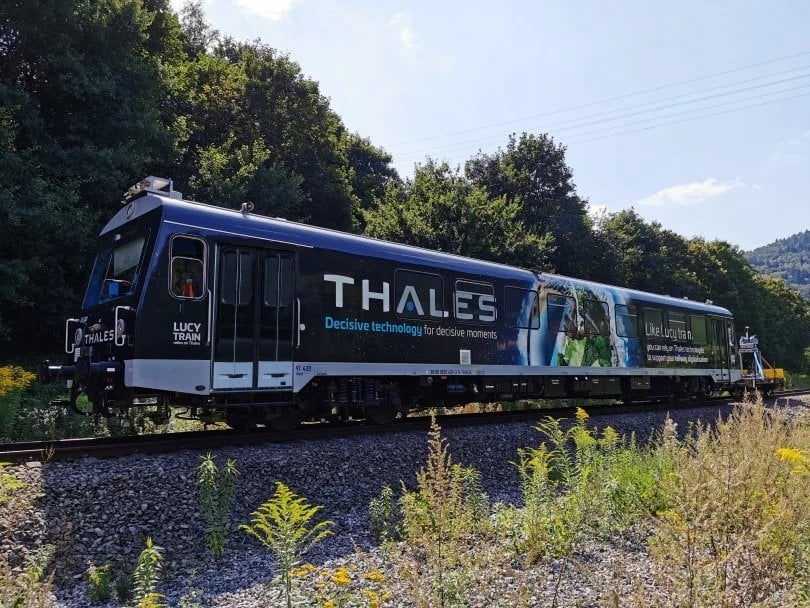THALES ROLLING LABORATORY LUCY DEDICATED TO AUTONOMOUS RAIL TECHNOLOGIES HAS ARRIVED AT INNOTRANS
Autonomous technology gives trains new super powers. Imagine if your train could see and think for itself. It sounds like science fiction, but thanks to Thales, trains with autonomous capabilities are already becoming a reality. RailBot, the Thales autonomous solution, enables a train to interpret its surroundings, make decisions and drive itself according to its mission, without any need for human intervention.

- For the first time, Thales’ rolling laboratory train Lucy has travelled to InnoTrans to demonstrate the company’s pioneering autonomous technologies. The trip began on September 2nd in Neustadt before making its way to InnoTrans in Berlin. A challenge called #SpotLucy, was launched where people could take a picture of the Lucy train and share it on social media.
- Built in 1994, Lucy is Thales’ rolling laboratory for testing on-board railway systems. Lucy is also equipped with a multitude of autonomous technologies.
- Thanks to its Train Control Management System (TCMS), Driver Assistant System, remote video control with GSM-R / 4G / 5G cellular equipment and position and location sensors, Lucy can determine its precise location and speed by itself. Furthermore, in the future, these technologies will enable it to detect, recognise and respond to objects in front of the train.
- Autonomy delivers both energy savings and performance enhancements leading to improved punctuality.Rail travel consumes 12 times less energy and emits up to 11 times less CO₂ per passenger / kilometre compared to cars and trucks. (IEA tracking report. Rail. November 2021)
We are not there yet, but several of the building blocks for autonomous operation are already being deployed or nearing maturity.
On-board Passenger Density Information and Video Security
Passenger information and video surveillance on trains provide enhanced comfort for travellers. Thales’ solution leverages existing CCTV networks at stations and on-board trains to provide real-time information on passenger density. Thales’ Video Analytics solution is based on a unique hardware embedded platform supporting advanced artificial intelligence algorithms. The solution monitors passenger density in order to balance efficiently the flow of passengers along train carriages. Thanks to real-time passenger information displays, travellers are oriented towards the less crowded carriages. Additionally, the Thales solution helps remote operators to manage crowds by adapting train scheduling through the Thales digital integrated platform.
The system supervises the Wayside & Onboard subsystems remotely in real time from an Operation Control Centre (OCC), controlling passenger density, saving energy and improving customer satisfaction. The use of 5G, the new generation of radio communications, enables the implementation of optimised telecommunications infrastructures, tailored to railway operators’ needs. 5G significantly boosts the performance and reliability of communications, with greater speed transmissions (up to 100x faster than 4G), very low latency and a greater capacity to connect multiple intelligent devices onto one network. 5G also enables innovative core elements of railways, including autonomous systems and smart maintenance.
RailBot™ APS – Advanced Positioning System
The innovative Advanced Positioning System is being tested as a new technology to ensure precise position detection of a vehicle, and includes sensors, such as IMU, GNSS, radars, etc. To heighten precision quality, so called ground truth techniques were added such as continuous GNSS-real time kinematic tracing or Eurobalise points. The test drives are being carried out with Thales’ own test vehicle Lucy, which offers ideal conditions as a test platform (installation of sensors etc.). In August 2021, the test route was fully topologically mapped, with infrastructure being measured with centimeter precision using a system consisting of LIDAR, GPS and cameras. A digital map (HD map) is created from this data, which serves as reference for testing the APS sensors as well as other future systems.
RailBot™ Eye - Obstacle detection
Obstacle detection is the ability to detect, classify and respond to objects in front of (and around) the train using sensors and sophisticated computer algorithms. Obstacle detection is a core feature in a fully autonomous and driverless system. This Thales solution provides trains with a new visual sense using Artificial Intelligence to navigate autonomously in an “open-world environment”. It will be used in normal traffic, as the train will be able to distinguish between relevant types of obstacles and determine the level of risk in order to take the right decision.
“Autonomy is still a work in progress with technologies that are maturing rapidly. Thales has a clear vision for autonomy and is working in partnership with its customers and partners to deliver the transformation." - Dr. Yves Joannic, VP Main Line Signalling Managing Director, Ground Transportation Systems Thale
Autonomy delivers both energy savings and performance enhancements that make rail more attractive to passengers. Taking the train is an attractive alternative to journeys by road, with railways consuming 12 times less energy and emiting up to 11 times less CO₂ per passenger / kilometre compared with cars and trucks.
Discover Thales autonomous technologies and Lucy, the Thales lab for autonomous rail solutions at InnoTrans 2022 in Berlin from September 20 to 23 (stand #670, #571 - Hub27), the world's leading trade fair for Transport industry.
www.thalesgroup.com

